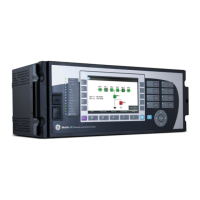CHAPTER 8: APPLICATION OF SETTINGS LINES WITH TAPPED TRANSFORMERS
L90 LINE CURRENT DIFFERENTIAL SYSTEM – INSTRUCTION MANUAL 8-23
8
8.6.2 Ground directional overcurrent
Ground directional overcurrent function (negative-sequence or neutral) uses an offset impedance to guarantee correct
fault direction discrimination. The following setting rules apply:
• If the net impedance between the potential source and the local equivalent system is inductive, then there is no need
for an offset. Otherwise, the offset impedance shall be at least the net capacitive reactance.
• The offset cannot be higher than the net inductive reactance between the potential source and the remote equivalent
system. For simplicity and extra security, the far-end busbar can be used rather than the remote equivalent system.
As the ground directional functions are meant to provide maximum fault resistance coverage, it is justified to assume that
the fault current is very low and none of the series capacitors is guaranteed to get by-passed. Consider settings of the
negative-sequence directional overcurrent protection element for the Sample Series Compensated System.
For the Sending Bus relay, bus-side VTs:
• Net inductive reactance from the relay into the local system = –2 + 3 = 1 Ω > 0; there is no need for offset
• Net inductive reactance from relay through far-end busbar = –4 + 10 – 3 = 3 Ω; the offset cannot be higher than 3 Ω
• It is recommended to use 1.5 Ω offset impedance
For the Sending Bus relay, line-side VTs:
• Net inductive reactance from relay into local system = –2 + 3 – 4 = –3 Ω < 0; an offset impedance ≥3 Ω must be used
• Net inductive reactance from relay through far-end busbar = 10 – 3 = 7 Ω; the offset cannot be higher than 7 Ω
• It is recommended to use 5 Ω offset impedance
For the Receiving Bus relay, bus-side VTs:
• Net inductive reactance from relay into local system = –5 + 7 = 2 Ω > 0; there is no need for offset
• Net inductive reactance from relay through far-end busbar = –3 + 10 – 4 = 3 Ω; the offset cannot be higher than 3 Ω
• It is recommended to use 1.5 Ω offset impedance
For the Receiving Bus relay, line-side VTs:
• Net inductive reactance from relay into local system = –3 – 5 + 7 = –1 Ω < 0; an offset impedance ≥1 Ω must be used
• Net inductive reactance from relay through far-end busbar = 10 – 4 = 6 Ω; the offset cannot be higher than 6 Ω
• It is recommended to use 3.5 Ω offset impedance
8.7 Lines with tapped transformers
8.7.1 Overview
The L90 protection system can be applied to lines with tapped transformer(s) even if the latter has its windings connected
in a grounded wye on the line side and the transformer(s) currents are not measured by the L90 protection system. The
following approach is recommended.
If the setting
SYSTEM SETUP L90 POWER SYSTEM ZERO-SEQ CURRENT REMOVAL is “Enabled,” all relays at the line
terminals are calculating zero-sequence for both local and remote currents and are removing this current from the phase
currents. This ensures that the differential current is immune to the zero-sequence current out-feed caused by the in-zone
transformer with a primary wye-connected winding solidly grounded neutral.
At all terminals the following is being performed:
I_L_0 = (I_L_A + I_L_B + I_L_C) / 3) : local zero-sequence current
I_R_0 = (I_R_A + I_R_B + I_R_C) / 3 : remote zero-sequence current
Now, the I_PHASE – I_0 values (for Local and Remote) are being used instead of pure phase currents for differential and
restraint current calculations.
For example, the operating current in phase A is determined as:
I
2
op_A = |(I_L_A – I_L_0) + (I_R_A – I_R_0) |
2
: squared operating current, phase A

